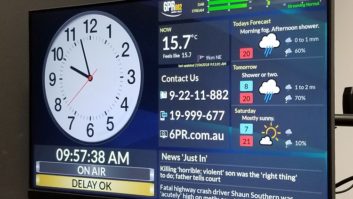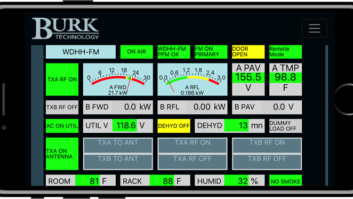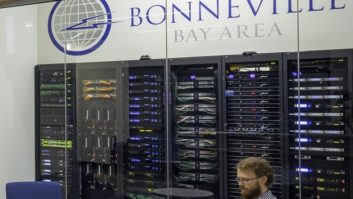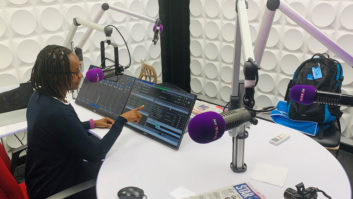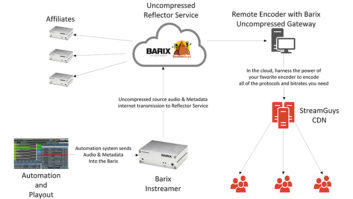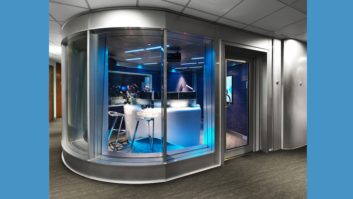We left the subject of “category” cables in the April 24 issue, talking about return loss.
This is a new specification for twisted pairs. It shows, in dB, the ratio of signal strength received at the destination to the signal that is reflected back to the source. It is the same as VSWR, which shows the direct/reflected energy in transmission lines.
Of course, VSWR is a ratio not in dB, but you can convert from one to the other.
Hold on a minute! Transmission lines are huge, high-power coaxes used to carry power from transmitters to antennas. When you have really bad VSWR, you don’t just lose power; your cable blows up, possibly along with your transmitter!
Blown
Many a grizzled engineer has a piece of blown transmission line sitting in his office. This trophy is to prove the life-threatening aspects of his job and to scare off the junior engineers who think they want to work on transmitters before they even know what a grounding rod is.
Perhaps return loss on a twisted-pair data cable is not life-threatening, but it certainly can be network-threatening.
We’re talking about twisted pairs running at bandwidths up to 250 MHz, for Category 6 at least, and up to 1 gigabit of data per second. You would certainly want all of those bits to get to the destination device. Good return loss numbers assure that this will happen.
Just think. In recent memory of many readers, you could have earned laughs at any engineering luncheon by saying, “We’re going to run 250 MHz down a twisted pair.”
And now they’re talking about future premise/data cables running 600 MHz per pair, or rumors of 1 GHz per pair.
And, speaking of rumors, there’s talk that, with the ratification of Cat-6, the TIA/EIA committee will drop Category 5, just as it did Category 4, from their “recognized” product list.
Will this insanity ever end? I hope not!
One system being proposed is CobraNet. Started by the folks at Peak Audio, this trademarked technology now is an accepted standard for a dozen other manufacturers including Biamp, Clear-com, Creative Audio, Crest Audio, Crown, Digigram, EAW, Peavey, QSC, Rane and Whirlwind. More manufacturers are jumping on the bandwagon all the time.
You will note that many of these manufacturers make power amps. This should give you a clue as to what CobraNet actually does. You can get more details at www.peakaudio.com.
It is based on regular Ethernet, designed to run on UTP, unshielded twisted-pair data cable, like Category 5. But the payload is multichannel audio, up to 128 channels.
Aimed mainly at live performance/theatrical venues, CobraNet certainly would make the design and set-up of these installations at lot easier and faster. And all you need do is buy devices with the appropriate input/output, with hubs and routers made by the same people who made them for your 100baseT data network.
There are a couple of problems.
First, category cables are not intended for temporary installations. They are for permanent installs. They are solid conductors and are not particularly rugged.
Performance and reliability are not the issue. After all, the data stream at your bank, or the IRS, or any other large corporation, runs on solid-conductor Cat-5 (or 5e, or 6).
Are you saying that your audio is more critical than your bank account? Or your IRS account?
No, the first problem is simply ruggedness. Cat-5 is not a “field cable”. And, in this application, if a Cat-5 cable is mashed, mangled or cut, you don’t just lose a mic line or two, you lose the entire show!
While cables can be installed in protected areas, many theatrical installs require the cable to go through the audience. Just think about multichannel audio snakes that you install now. It is in those locations that you will want to put data cable.
If this is a heavy-metal concert or a grunge band with a mosh pit, you can imagine generic Cat-5 would not be a good choice for a standard data cable.
Luckily, there are “ruggedized” versions of Category 5e and Category 6 cables available. Some have double-jackets, called “up-jacketed” designs. Others have interlocking steel armor with a jacket over that. This last data cable truly is “mosh-pit-proof.” If you’re trying to get those 128 channels to the front-of-house mixer, that’s certainly the way to go.
The second problem has been the “mosh-pit-proof” connector to go with it. The standard RJ-45 connectors are not rugged, as any data installer will attest. They’re just little plastic connectors.
But Neutrik, the audio connector people from Liechtenstein, recently brought out a ruggedized RJ-45. They put the RJ-45 connector inside a shell, not unlike an XLR.
So now you have a “mosh-pit-proof” connector and the “mosh-pit-proof” cable to go with it.
If you have a large multichannel broadcast install, such as a multistudio master control building, perhaps CobraNet is an alternative to consider.
There are other, often proprietary multichannel audio delivery systems available. The Klotz Vadis system is one aimed at broadcasters. This is a fiber optic-based network. All your inputs and outputs go into the Vadis box, which are all linked by single-mode fiber. You can run multiple fibers, in different directions, to reduce the failure potential.
Even Otari, the recorder and console manufacturer, is coming out with a multichannel networked format.
Of course, the AES tried to do something similar with Multichannel Audio Distribution Interface. MADI could send up to 56 channels of digital audio down a single coax. It’s still available as an option on some block-long recording consoles, but never made it into the broadcast world, as far as I know.
Next time, we’ll look at other data cables vying for acceptance. Among them are USB, and IEEE 1394 Firewire. We’ll also wire up some computer monitors for VGA, S-VGA or the emerging X-VGA.






